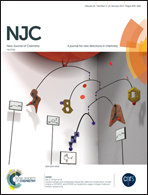Facile heat reflux synthesis of blue luminescent carbon dots as optical nanoprobes for cellular imaging†
Abstract
We rapidly prepared photoluminescent carbon dots (CDs) using a single-step heat reflux method with L-glutamic acid as the carbon source. The as-prepared CDs possessed a quasispherical morphology with an average diameter of approximately 5.42 nm and a quantum yield of approximately 6.3%. The CDs clearly exhibited excitation-dependent photoluminescence and good temperature-sensitive photoluminescence, as well as excellent water-solubility. Moreover, the luminescent CDs could not only be efficiently taken up by CT26.WT and CAL-27 cells but also exhibited low cytotoxicity and favourable biocompatibility, making them promising candidates for cellular imaging applications, among others.



 Please wait while we load your content...
Please wait while we load your content...